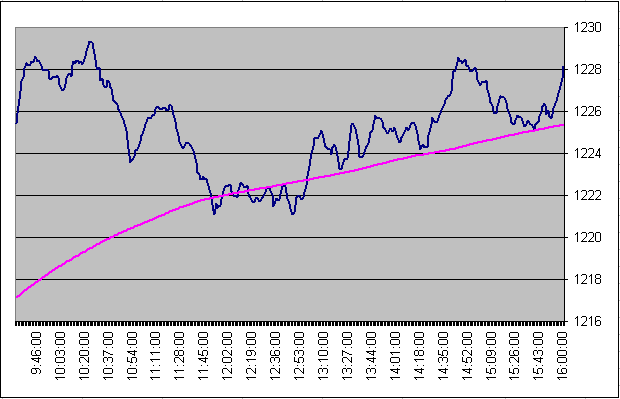To come back to this discussion, i would like first to remind what the Cumulative Tick is:
"The NYSE tick is the number of stocks whose current price is higher than the previous trade (uptick) minus the number whose current price is lower than the previous trade (downtick). This takes the entire NYSE Market into account."
This means that the NYSE Tick changes every millisecond or less. It is therefore a "snapshot" picture taken at a certain time. If between two snapshot pictures, 15 stocks had an uptick and 10 had a downtick, the different is +5. The cumulative tick would simply add this number every time a snapshot picture is taken.
When such snapshots are taken at intervals of 5 seconds, there will of course be more moves (higher numbers) than for snapshots taken every 0.001 second. However, within 5 seconds, many stocks can have upticks AND downticks. What we measure is simply the different for each stock (Up - Downticks.) This means that snapshots that are taken at longer time interval will produce lower figures of cumulative ticks.
For our back-tests, we have used the IQ feed historical minute based cumulative tick. This Minute based cumulative tick is slower than a cumulative tick that would take snapshots every five seconds.
We could of course switch to a faster cumulative tick, but the back-test is based on the minute Cumulative tick and no other data is available for the purpose of back-testing.
Therefore, we will simply keep the current cumulative tick, but rename it the "Minute based Cumulative Tick."
Moving to 1200 Cumulative Tick average
However, thanks to this discussion, we had an in depth review of our calculations of the 600 Minutes average. We discovered that the JAVA based calculation led to different figures compared to the historical calculation for the average figure that I performed for my back-tests in VB. This led us to discover that the back-test has been performed using single precision variables instead of a double precision. This means that the 600 minutes average calculated using single precision variables was slower to move than it should normally have been if we had used double precision variables.
As a consequence, a new back-test was executed using double precision variables. This back-test was performed using a set-up period between July 2007 and end of 2009, and a control period between 2010 and the end of 2012. This back-test showed that the 600 CT had to be replaced by a 1200 minutes average CT.
As a reminder, the CT will be used in the RT 20DMF as a confirmation tool for short signals only. A 1200 Average CT means that the CT will need to show on average three days of weakness in order to confirm a short signal (390 * 3 = 1170.) Below is an example of the 600 and 1200 Minutes average CT
Attachment 16325
I attach an excel sheet that includes the new 20DMF RT back-test results on EOD and RT data.
The RT data are only valid from June 2009.
Attachment 16328
The comparative return table is shown below. The RT system clearly shows out-performance for both long and short trades.
Attachment 16327
